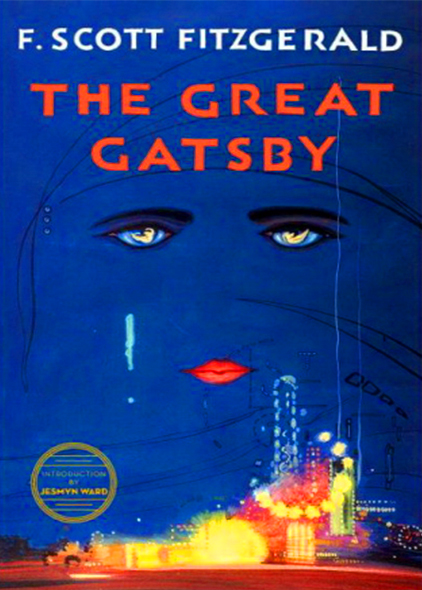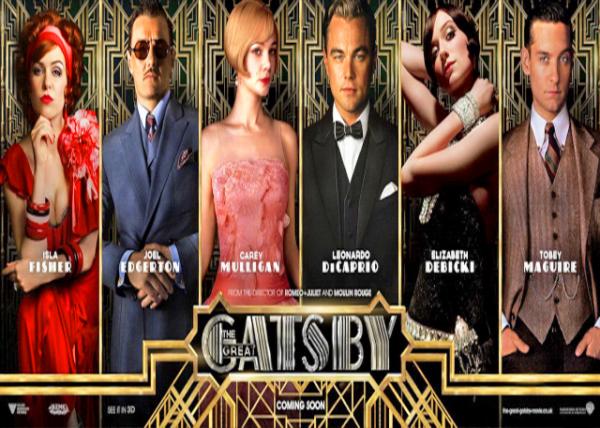2020-08-23 【Aiden in English】
Staring out into the clear pool of the American conscience, 1920s America indulged in the idealistic belief of personal success and self-made wealth. In The Great Gatsby, author F. Scott Fitzgerald explores the corruption of the American Dream, investigating the darkness that lurks beneath the surface of fantasy. Through the descriptions of the Green Light, the Valley of Ashes, and the eyes of Dr. T.J. Eckleburg, Fitzgerald analyzes the corrupt state of the once-glorious American Dream. At the surface of a murky lake, the calm waters often attract viewers with deceptive beauty; dive deeper, and one uncovers the cold corruption beneath the dream. In "Deep Summer and in Front of Wayside Garages" (Fitzgerald 20), Nick finds Jay Gatsby reaching for "a single green light" (21) at the end of a dock. As a man of immense wealth and power, Gatsby should have everything he desires; however, the green light still entices him, symbolizing a prize he cannot obtain. Fitzgerald also implements descriptive imagery of verdant scenery, characterizing the night as filled with "wings beating in the trees and a persistent organ sound" (20). Emphasizing the world's natural beauty, Fitzgerald alludes to the green light's purity and simplicity, characteristics that make the light beautiful. In the eyes of Gatsby, the solitary light represents Daisy—a guiding light towards the East Egg society. From a broader perspective, it also epitomizes the unadulterated American dream—an unattainable treasure that Gatsby seeks but no longer deserves. Introducing the idealistic American dream as the green light, Fitzgerald slowly builds corruption within the light itself. When Mrs. Wilson chants Daisy's name in Tom's presence, he brutally breaks "her nose with his open hand" (37). Later on, after Mrs. Wilson's tragic death and Tom and Daisy run away, Nick realizes that they were "careless people… they smashed up things and… retreated into their money or their vast carelessness" (179). As the living symbol of the green light, Daisy is revealed to be just as contaminated as the rest of Gatsby's world. Fitzgerald introduces the green light as Gatsby's dream, only to slowly twist its appearance into a nightmare. At a distance, Daisy appears to be the girl of these fantasies; the closer he steps, the more corruption he finds. The green light, reflecting the state of the American dream, is corrupt and murky below the surface. Wealth and money protect the immoral actions of the filthy rich— Gatsby being among that class. Through the idealization of Daisy's green light, Fitzgerald contrasts the surface of the American dream with its reality, establishing the corrupt nature of the fantasy. While the green light symbolizes the beauty and superficial perfection of the American dream, the Valley of Asses mirrors the grimy industry underneath. When Nick catches Gatsby entranced by the light, Fitzgerald intentionally details the sights and sounds of a bustling summer evening. In stark contrast, the Valley of Ashes is described as "a fantastic farm where ashes grow like wheat into ridges and hills and grotesque gardens" (23). Fitzgerald significantly contradicts the imagery between the ash and light, which at first appear to differentiate two distinct aspects of the American Dream, especially since the light and valley are introduced virtually simultaneously. Furthermore, while Daisy represents a verdant green light, ash symbolizes the gray decay of an industrial economy. Situated between the East and West eggs, the Valley of Ash is depicted in dark, gray images, featuring "ash-gray men," "rising smoke," and "powdery air" (23). Mr. and Mrs. Wilson reside within the valley. The couple, like their surroundings, is a product of commerce. Mr. Wilson is described as a "spiritless man" who appears bleached by the dull ask (25). Mrs. Wilson, on the other hand, is in an affair with Tom, desperate to escape her gray prison. As citizens of Ash, they embody the dark lifestyle of those who fail in the corrupted dream and instead are trapped in poverty. No dream exists without a corresponding nightmare. The ideal American dream is filled with gold and glory; Fitzgerald portrays reality as polluted with foulness. The Valley of Ashes is a direct product of industry built from economic greed. In the 1920s, large corporations dominated the industrial landscape. Built by people who clawed their way up in any method, they completed their "American dream"; however, for everyday dreamers like the Wilsons, the dream drifts further and further out of reach. Mrs. Wilson cheats on her husband not in terms of love but for the opportunity to crawl out of the valley. Fitzgerald proposes the Valley of Ashes as a message that the new dream is neither obtainable nor glorious, as popular conception suggests. This idea is exemplified in the juxtaposition of gray and yellow. While the poisoned delusion is gray, it takes the form of "yellow dresses" (42) and Jordan's "golden arm" (47) in the presence of money. Fitzgerald almost personifies the American dream as a sleazy salesman who dons lovely attire but only appears well-cultured to sell counterfeit diamonds. Corrupt with greed, his usage of the Valley of Ashes and its inhabitants reflects the negative foundations of a fraudulent dream. Linked closely to the Valley of Ashes are the eyes of Dr. TJ Eckleburg. Referring to a billboard advertisement for an oculist, these eyes resemble the role of God. "Blue and gigantic," the retinae look out over the valley through a "pair of enormous yellow spectacles" (23). Above the dull gray ash atmosphere, the blue color pierces through the image, while the yellow highlight connects T.J. Eckleburg to corrupt wealth. Later, Mr. Wilson sees T.J. Eckleburg's retinae on a billboard and reads, "God sees everything," to which Michaelis replies, "That's an advertisement" (160). This interaction establishes TJ Eckleburg as a divine figure—a deity casting its presence over the Valley of Ashes. Fitzgerald creates this god-like persona to solidify that even the purest entities can be tainted in this new American dream. Contrary to the loving God preached in churches, T.J. Eckleburg reflects the idea of the American dream. Fitzgerald brands a new divinity to set apart the original dream's intentions of honesty and hard work from the mutated cult of backroom deals and illegal trading. Creating the eyes of T.J. Eckleburg also brings a manufactured quality to the setting. Because of God's pure image, the novel's counterpart reflects the growing trend that everything is profitable. The lack of morals displays America's deluded path; honesty no longer benefits anyone. Furthermore, directly after Mr. Wilson witnesses the eyes of T.J. Eckleburg, he murders Gatsby and commits suicide. The brutal sequence of events emphasizes the new gods and society's inhumane principles. By creating the distant and alien eyes of T.J. Eckleburg, Fitzgerald claims the American dream has lost basic morals, dehumanizing the American people. Fitzgerald emphasizes the corruption in American fantasy through three prominent symbols. Nothing is what it appears on the surface; the depths determine the true nature of any object. The American dream once stood for honesty and hard work. Now, the murky waters have clouded its clear message. 【红霞译】
天地良心,廿世纪廿年代美国沉迷于个人成功及白手致富的理想主义信念。中篇小说《了不起的盖茨比》中,作者弗朗西斯·司各特·菲茨杰拉德着重探讨变质的美国梦,并就幻想背后的黑暗进行调查研究,通过绿灯、灰谷以及埃克尔堡医生三条主线,剖析了曾经荣耀美国梦最终走向幻灭的变化过程。
湖面上污渍漂浮,静谧的湖水不时散发出诱人的光泽;透过现象看本质,梦幻已掺带杂念。在“炎热的气息弥漫到路边车库前”(20),尼克发现杰伊·盖茨比在码头尽端找到了“一盏彻夜不灭的绿灯”(21)。盖茨比有钱有势,想干什么就干什么;然而,绿光始终吸引他,象征着他追求虚无缥缈的东西。作者还描绘翠绿景色,刻画夜晚“羽翼在林中扑腾和奏出经久不息的风琴乐声”(20),通过勾勒自然美,暗指绿光单纯清新,衬托美好憧憬。在盖茨比眼里,孤独的光芒是黛西的化身──通往长岛东蛋镇上流社会的航标灯。从更广泛的角度来看,它是纯正美国梦的缩影──盖茨比寻找从不属于自己的财富。
作者将绿光引入带有理想色彩的美国梦,然后再渐渐地笼罩腐败阴影。当威尔逊太太在汤姆面前高呼黛西名字时,他残酷地“动手打断她的鼻子”(37)。不久,威尔逊太太惨死,汤姆和黛西出逃,尼克意识到他们都是“自私冷酷的人…砸碎了东西…退缩到自己的金钱或者麻木不仁”(179)。绿灯象征着不切实际的幻想,那正是盖茨比为黛西倾其一生的追求,作者将绿灯写进盖茨比幻想之中,慢慢地让它变成梦魇。距离遥远时,黛西是盖茨比痴迷的女孩;重新见面后,盖茨比发现黛西早已被金钱腐蚀。绿灯表面上是美国梦的化身,实际上却是颓废迷惘的代名词。财富与金钱让浑身铜臭味的人道德沦丧──盖茨比自甘堕落。通过赋予黛西那盏具有象征意义的绿灯,作者对比了美国梦的表象与现实,进而揭示幻想破灭的本质所在。
如果说绿灯象征着美国梦的魅影魔力,那么灰谷则是社会底层的垃圾场。当尼克遇到被绿灯吸引来的盖茨比时,作者特意详述夏日热闹夜景和声音。与之形成鲜明对照的是,灰谷“是一个梦幻般的农场,这儿的灰沙像麦子一样疯长,长在山脊、山丘和奇形怪状的花园里”(23)。作者突出刻画了灰沙和绿光之间的反差,乍看上去似乎把美国梦分成两个不同方面,尤其因为同时引入灰谷和东蛋镇。此外,黛西代表青翠的绿光,灰沙象征工业化经济的衰落。地处东蛋、西蛋两镇之间的灰谷荒凉萧条,“人似土灰”,“袅袅炊烟”,“尘土飞扬”(23),威尔逊夫妇就住在灰谷里,如同周围环境一样,他们也是商品经济的产物。一方面,威尔逊先生无精打采,百无聊赖(25);另一方面,威尔逊太太与汤姆大搞婚外情,想要私通,作为灰谷一员,他们经历的无外乎浮华背后上流阶层的道德沦丧和中下层贫苦百姓的生活。 日有所思夜有所梦,做梦免不了做噩梦。理想的美国梦充满黄金与辉煌,作者绘制出一幅被罪恶玷污的现实图画,灰谷就是建立于拜金主义之上资本主义工业化发展的直接产物。上个世纪爵士乐时代,大公司主导工业格局,那些不择手段爬上去的人实现了“美国梦”,而对于像威尔逊夫妇这样的普通幻想家来说,幻想越来越遥不可及。威尔逊太太并非出于爱,为了离开灰谷而不惜欺骗丈夫。作者把灰谷视为无梦可追无荣可求,融合了灰、黄两种色调,尽管变态的社会环境自然灰暗无比,但有钱人却身着“黄色礼服”(42),乔丹挥展“金臂”(47)。在书中,美国梦跟卑鄙的推销员差不多──穿着体面且举止得体,但却干着挂羊头卖狗肉的勾当。由于贪婪而腐败,灰谷及其居民被写成滋生邪念的对象。
艾克尔堡医生的眼睛密切注视着灰谷,广告牌上张贴的是这位眼科医生那双像上帝眼睛的照片,“蓝色而巨大”,视网膜透过“一副硕大无比的黄色眼镜”(23)朝灰谷望去。灰暗尘土上面,天空湛蓝;这里黄色成为连接艾克尔堡与不义之财的媒介。后来,威尔逊先生盯着广告牌上艾克尔堡的视网膜自言自语地说:“上帝看见一切”,而米凯利斯回答道:“那不过是广告”(160),由此说明艾克尔堡是神圣人物──灰谷上举头三尺有神明。
作者创造了艾克尔堡这个类似于上帝的角色,表明再纯洁的地方都会被新生的美国梦蒙蔽,与教会中宣扬慈爱的上帝相反,埃克尔堡伸张的是“美国梦”思想,作者赋予人物以全新的神性形象,藉之区分美国梦所推崇的诚实勤奋与暗箱操作和非法交易所奉行的歪门邪道。借助打造埃克尔堡双眼,作者给情节增添了品质感;因为上帝圣洁,小说相关部分也要顺应剧情发展,道德沦丧标志着美国梦变质,诚实不再让人受益。 此外,在亲眼目睹埃克尔堡眼睛之后,威尔逊先生谋杀了盖茨比,同时也结束自己的性命,一系列悲剧事件暴露了人的信仰危机,并折射出社会的世态炎凉。通过塑造埃克尔堡遥远而陌生的眼睛,作者揭示美国梦已丧失基本道德,致使美国人丧失人性。 在三个突出代表中,作者强调幻想中的腐化贪婪,表面都是假象,透过本质才能看到真相。美国梦曾标榜诚实勤奋,如今早已变得含糊其辞。 Today in History(历史上的今天):
2018: Shanghai the Magic City, China(上海—魔城) 2018: Shanghai—Paris of the East, China(上海—东方巴黎) 2018: Shanghai Bund—Pearl of the Orient, CHN(上海外滩—东方明珠) 2018: Shanghai—Starbucks Reserve Roastery, China(上海—星巴克臻选烘焙工坊) 2018: Shanghai—A Bite of Local Cuisine, China(上海—舌尖上的申城) 2018: Shanghai—Lujiazui Financial District(上海—陆家嘴金融贸易区) 2017: Lucerne—Salvation through Christ, CHE(瑞士卢塞恩─救赎之城)
2017: Lucerne—Romantic Pearl of Swiss, CHE(瑞士卢塞恩─浪漫明珠)
2017: Lucerne the Mournful Lion, Swiss(瑞士卢塞恩─垂死狮子像)
2017: Lucerne the Chapel Bridge, Swiss(瑞士卢塞恩─教堂廊桥) 2017: Lucerne—Variety of Standard, Swiss(瑞士卢塞恩─多元文化) 2017: Basel the Fable Basilisk, Swiss(瑞士巴塞尔—蛇王仙境) 2017: Basel—Home to Roche & Novartis, CHE(瑞士巴塞尔—罗氏与诺华药业总部) 2010: 天大地大(Heaven and Earth) 2009: 证书奖状奖杯(Awards) 
The Great Gatsby 《了不起的盖茨比》  The Cast of The Great Gatsby (《了不起的盖茨比》电影演员) The Cast of The Great Gatsby (《了不起的盖茨比》电影演员)
Crosslinks(相关博文): 7th Grade Book Review─Thank You M'am(书评─《谢谢您,夫人》) 6th Grade Book Review─Head above Water(书评《浮出水面》) 6th Grade Book Review─Urban Outlaws(书评─浅议《城市水浒传》) 11th Grade(高中三年级) |
